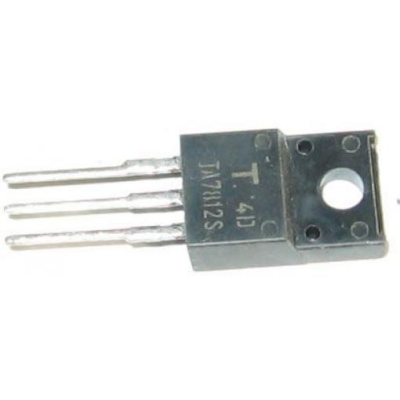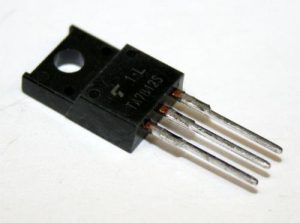TA7812S
Part Number: TA7812S
Manufacturer: Toshiba
Description: Linear Voltage Regulators
Shipped from: Shenzhen/HK Warehouse
Stock Available: Check with us
ICRFQ.com - Electronic Components Distributor in China Since 2003

Part Number: TA7812S
Manufacturer: Toshiba
Description: Linear Voltage Regulators
Shipped from: Shenzhen/HK Warehouse
Stock Available: Check with us
The TA7812S is a three-terminal positive voltage regulator that solves the distribution difficulties associated with single-point regulation. This regulator offers local on-card regulation and produces positive voltage.
The TA7812S represents a three-terminal positive voltage regulator. It can provide on-card regulation at the local level, eliminating the distribution issues inherent in single-point regulation. The TA7812S incorporates internal current limiting, thermal shut-down, and safe area protection, all of which contribute to the device’s virtually indestructible nature. It can provide an output current of over 1 A if suitable heat sinking is given. The TA7812S was primarily developed as a fixed voltage regulator; however, it is possible to acquire adjustable voltage and currents by using it in conjunction with components from the outside.

● It has an output current capability of 1.5 A.
● It can produce 5, 6, 8, 8.5, 9, 12, 15, 18, and 24 volts.
● Thermal overload prevention is a feature.
● Short circuit protection is a feature.
● Output transition SOA protection is a feature.
● It has a tolerance of 2% for output voltage (A version).
TA7812SApplications
● In most projects, a constant +12V output regulator powers microcontrollers and sensors.
● Used as a regulator with adjustable output.
● Used in particular situations as a current limiter.
● Controlled Dual Supply
● utilized as a circuit for output polarity protection.
STMicroelectronics is a global independent semiconductor business leader in developing and delivering semiconductor solutions throughout microelectronics applications. The firm was founded in 1969 and is headquartered in Switzerland. The company is at the forefront of System-on-Chip (SoC) technology, and its products are crucial in enabling today’s convergence trends. An unrivaled combination of silicon and system expertise, manufacturing strength, an Intellectual Property (IP) portfolio, and strategic partners positions the company in this leading position.
The TA7812S part number represents a three-terminal positive voltage regulator. This regulator can give local regulation on the card, doing away with the distribution issues that come with single-point regulation. It has built-in current limiting, thermal shut-down, and safe area protection, all of which contribute to the device’s virtually indestructible nature.
Adjustable Voltage regulators only need a small number of extra parts to function. Fixed voltage regulators need no extra parts (maybe a couple of bypass capacitors). You can choose from various voltage and current options at a reasonable cost.
To recognize it if it is packed as TO-220, turn it so that the writing is facing you and the pins are downward. From left to right, count to 123. Input is on pin 1, the ground is on pin 2, and the output is on pin 3. The input for the 78 Series voltage regulator chips must be DC; if the input and output are in the wrong order, the chip will burn. Additionally, the DC input voltage shouldn’t be excessive.
With an input voltage range of 14 to 35V, the 7812 fixed voltage linear regulator has a 12V output with a maximum current of 1A.
A resistor connected in series with a diode can be used to create an essential voltage/current regulator (or series of diodes). Diode V-I curves have a logarithmic shape, which means that variations in input or current draw have a minimal impact on the voltage across the diode. This concept might work well if precise voltage control and efficiency are not priorities. This voltage regulator is only appropriate for low voltage-controlled output because a diode’s forward voltage is relatively low.
A Zener diode or a series of Zener diodes may be used when a greater voltage output is required. The fixed reverse voltage of the Zener diode, which can be extremely high, is used by Zener diode regulators.
Feedback voltage regulators compare the actual output voltage to a predetermined reference voltage. Any variation is boosted and utilized to regulate the regulation element to lower the voltage error. Raising the open-loop gain enhances regulation precision but reduces stability, resulting in a negative feedback control loop. Additionally, there will be a trade-off between stability and change in response time. If the output voltage is too low, the regulation element is taught to create a higher output voltage by lowering less of the input voltage or by drawing input current for longer periods.
If the output voltage is too high, the regulation element is typically instructed to produce a lower voltage. However, many regulators contain over-current protection, so if the output current is too large, they will stop sourcing current (or limit it in another way). Some regulators may shut down if the input voltage exceeds a specific range.
Automatic voltage regulators (AVRs) are used in generators that are utilized in power plants, ships that produce their electricity, and backup power systems to stabilize the voltage as the load on the generators changes. Modern AVRs use solid-state components instead of the electromechanical technologies used in the first AVRs for generators. An AVR is a feedback control system that gauges the generator’s output voltage, compares it to a predetermined value, and produces an error signal to modify the generator’s excitation.
The generator’s terminal voltage will rise as the excitation current in the field winding rises. The AVR will employ power electronic devices to control current; typically, just a tiny portion of the generator’s output is required to supply current for the field winding. The reactive power that a generator produces when it is connected in parallel with other sources, such as an electrical transmission grid, is more affected by changes in excitation than its terminal voltage, primarily determined by the connected power system. The AVR system will feature circuits to ensure that all connected generators function at the same power factor when connected in parallel. Grid-connected power plant generators’ AVRs could incorporate extra control functions to help the grid maintain stability in the event of abrupt load loss or breakdowns.
Thanks for Reading. Continue browsing through our website to get more great content like this one. If you think that there is something we might have missed or have a question regarding this article or any other in our article, then feel free to comment in the section provided below, and we will do our best to respond to them.
If you need more details or want to place an order for TA7812S, ICRFQ is the place to do it. We guarantee the lowest prices and highest quality because we are the leading electronics distributor in China.
WhatsApp us